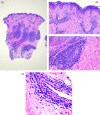Skin manifestations of COVID-19 in children: Part 3
- PMID: 33207021
- PMCID: PMC7753282
- DOI: 10.1111/ced.14483
Skin manifestations of COVID-19 in children: Part 3
Abstract
The current COVID-19 pandemic is caused by the SARS-CoV-2 coronavirus. The initial recognized symptoms were respiratory, sometimes culminating in severe respiratory distress requiring ventilation, and causing death in a percentage of those infected. As time has passed, other symptoms have been recognized. The initial reports of cutaneous manifestations were from Italian dermatologists, probably because Italy was the first European country to be heavily affected by the pandemic. The overall clinical presentation, course and outcome of SARS-CoV-2 infection in children differ from those in adults as do the cutaneous manifestations of childhood. In this review, we summarize the current knowledge on the cutaneous manifestations of COVID-19 in children after thorough and critical review of articles published in the literature and from the personal experience of a large panel of paediatric dermatologists in Europe. In Part 1, we discuss one of the first and most widespread cutaneous manifestations of COVID-19, chilblain-like lesions, and in Part 2 we expanded to other manifestations, including erythema multiforme, urticaria and Kawasaki disease-like inflammatory multisystemic syndrome. In this part of the review, we discuss the histological findings of COVID-19 manifestations, and the testing and management of infected children for both COVID-19 and any other pre-existing conditions.
© 2020 British Association of Dermatologists.
Figures


References
-
- Llamas‐Velasco M, Chicharro P, Rodríguez‐Jiménez P et al. Reply to "Clinical and histological characterization of vesicular COVID‐19 rashes: a prospective study in a tertiary care hospital": pseudoherpetic Grover disease seems to appear in patients with COVID‐19 infection. Clin Exp Dermatol 2020. 10.1111/ced.14305 - DOI - PMC - PubMed
Publication types
MeSH terms
Substances
LinkOut - more resources
Full Text Sources
Medical
Research Materials
Miscellaneous

